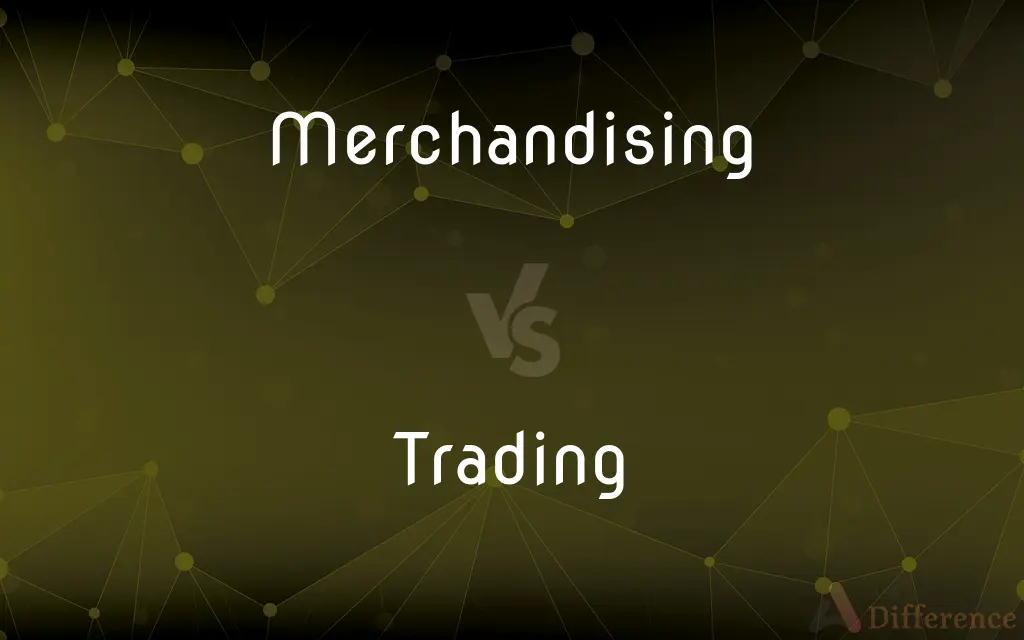Merchandising vs. Trading — What's the Difference?
Edited by Tayyaba Rehman — By Urooj Arif — Updated on February 24, 2024
Merchandising involves promoting and selling products, focusing on presentation and assortment to maximize sales. Trading refers to buying and selling goods or financial instruments, focusing on short-term profit through price differences.

Difference Between Merchandising and Trading
Table of Contents
ADVERTISEMENT
Key Differences
Merchandising is a key retail strategy that encompasses product selection, display, promotion, and sales tactics to enhance consumer appeal and increase sales volume. It's about presenting products in the most attractive way, ensuring they meet customer needs and preferences. Trading, in contrast, is a broader concept that applies to various markets, including commodities, stocks, and currencies. It involves the exchange of goods or financial assets with the aim of capitalizing on market fluctuations to generate profit.
In merchandising, the focus is on the end consumer and how products are marketed to them, including pricing strategies, store layout, and promotional activities. Merchandisers must understand their target market deeply to tailor their strategies effectively. Trading, however, is more concerned with the movement of goods or assets between parties, often without a direct focus on the final consumer. Traders seek to benefit from buying low and selling high, relying on market trends and analysis rather than consumer behavior.
Merchandising requires a blend of creativity and analytical skills to design appealing displays and promotions that resonate with shoppers, aiming to enhance the shopping experience and encourage purchases. Trading demands a different skill set, emphasizing analytical and strategic thinking to navigate market dynamics and make informed buying or selling decisions based on economic indicators, market sentiment, and financial analysis.
The success of merchandising is measured by sales growth, customer satisfaction, and brand loyalty, reflecting the effectiveness of product assortment, presentation, and promotional strategies in attracting and retaining customers. In trading, success is gauged by the profitability of transactions, with traders focusing on return on investment (ROI) and the ability to capitalize on market opportunities.
Merchandising and trading both involve the movement of goods and aim to generate profit, while they operate in distinct contexts with different objectives and strategies. Merchandising seeks to maximize sales through consumer engagement and product presentation, whereas trading aims for financial gain through strategic buying and selling in various markets.
ADVERTISEMENT
Comparison Chart
Focus
Product presentation and sales in retail
Buying and selling goods/assets for profit
Key Objective
Enhance consumer appeal and increase sales volume
Capitalize on price differences for short-term profit
Strategies
Product selection, display, promotion
Market analysis, buying low and selling high
Target
End consumers
Market opportunities
Skills Required
Creativity, market understanding, customer focus
Analytical, strategic thinking, market analysis
Compare with Definitions
Merchandising
Enhancing product appeal through strategic presentation.
Effective merchandising led to a noticeable increase in sales.
Trading
Buying and selling goods or assets for profit.
He made a substantial profit from trading stocks.
Merchandising
Involves careful product selection and placement.
The store's merchandising focused on seasonal items.
Trading
Focuses on exploiting market fluctuations.
Currency trading requires a keen eye on global economic trends.
Merchandising
Tailors strategies to consumer preferences.
Merchandising adjustments were made based on customer feedback.
Trading
Utilizes analysis of market trends and data.
Her trading decisions were based on thorough market analysis.
Merchandising
Uses promotions to attract customer interest.
The holiday merchandising campaign was a huge success.
Trading
Involves risk assessment and management.
Successful trading demands strict risk management strategies.
Merchandising
Aims to create an engaging shopping experience.
The new merchandising layout made shopping easier and more enjoyable.
Trading
Seeks short-term gains through strategic transactions.
Day trading involves making multiple trades for quick profits.
Merchandising
The promotion of merchandise sales, as by coordinating production and marketing and developing advertising, display, and sales strategies.
Trading
An exchange of one thing for another
Baseball teams making a trade of players.
Merchandising
Merchandising is any practice which contributes to the sale of products to a retail consumer. At a retail in-store level, merchandising refers to displaying products that are for sale in a creative way that entices customers to purchase more items or products.
Trading
A branch or kind of business
The women's clothing trade.
Merchandising
The activity of promoting the sale of goods, especially by their presentation in retail outlets
Problems rooted in poor merchandising
Trading
The people working in or associated with a business or industry
Writers, editors, and other members of the publishing trade.
Merchandising
The sale of merchandise in connection with an established brand, such as a sports team or a film.
Trading
The activity or volume of buying or selling
The trade in stocks was brisk all morning.
Merchandising
The promotion of goods for sale in a store, especially through advertising, attractive displays, discounts, etc.; also (generally), the promotion of any goods or services for sale.
Trading
The carrying on of trade.
Merchandising
(specifically) The promotion of a film, music group, theatre production, etc., through the sale of goods bearing motifs associated with the subject being promoted; also, such goods themselves collectively; merchandise.
Trading
Carrying on trade or commerce; engaged in trade; as, a trading company.
Merchandising
The exchange of goods for an agreed sum of money
Trading
Venal; corrupt; jobbing; as, a trading politician.
Trading
Buying or selling securities or commodities
Common Curiosities
What role does customer behavior play in merchandising?
Understanding customer behavior is crucial in merchandising to tailor product offerings, displays, and promotions that resonate with target audiences.
Can trading be done by individuals?
Yes, individuals can participate in trading, especially in stock, currency, and commodities markets, often through online platforms.
How do trends affect merchandising strategies?
Merchandisers must stay abreast of trends to ensure their product selections and promotional strategies align with current consumer interests and preferences.
How do companies use merchandising?
Companies use merchandising techniques to strategically place and promote products in stores or online to maximize visibility and attractiveness.
What skills are important for successful trading?
Critical skills for trading include analytical ability, understanding of market dynamics, risk management, and decision-making under uncertainty.
What is the goal of merchandising?
To increase sales and customer satisfaction by effectively presenting and promoting products to appeal to consumers.
What are some common trading markets?
Common trading markets include stocks, bonds, commodities, currencies (Forex), and derivatives.
Is trading only about financial products?
While trading often involves financial products, it can also include physical goods, such as in commodity trading or wholesale trade.
Can merchandising strategies differ online and in-store?
Yes, merchandising strategies can vary significantly between online and physical retail environments due to different consumer behaviors and presentation possibilities.
How do seasonal changes influence merchandising?
Seasonal changes significantly impact merchandising, requiring adjustments in product offerings, displays, and promotions to align with consumer needs.
What are the risks associated with trading?
Trading risks include market volatility, liquidity issues, and the potential for significant financial loss, especially in leveraged or speculative trades.
How do traders decide when to buy or sell?
Traders use a combination of technical analysis, market trends, economic indicators, and news events to make informed buy or sell decisions.
Are there ethical considerations in trading?
Yes, ethical trading involves transparency, fairness, and compliance with regulations to ensure market integrity and investor protection.
How do merchandisers measure the success of their strategies?
Success in merchandising is measured by sales performance, customer feedback, and the ability to meet or exceed targeted sales goals and metrics.
What impact does effective merchandising have on a brand?
Effective merchandising can enhance brand image, foster customer loyalty, and increase overall sales and profitability.
Share Your Discovery

Previous Comparison
Clarify vs. Confirm
Next Comparison
Jot vs. DotAuthor Spotlight
Written by
Urooj ArifUrooj is a skilled content writer at Ask Difference, known for her exceptional ability to simplify complex topics into engaging and informative content. With a passion for research and a flair for clear, concise writing, she consistently delivers articles that resonate with our diverse audience.
Edited by
Tayyaba RehmanTayyaba Rehman is a distinguished writer, currently serving as a primary contributor to askdifference.com. As a researcher in semantics and etymology, Tayyaba's passion for the complexity of languages and their distinctions has found a perfect home on the platform. Tayyaba delves into the intricacies of language, distinguishing between commonly confused words and phrases, thereby providing clarity for readers worldwide.















































